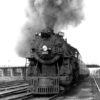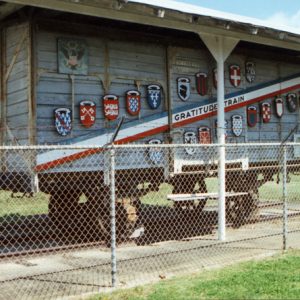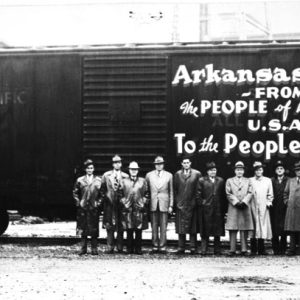calsfoundation@cals.org
Merci Train
aka: Gratitude Train
aka: Train de Reconnaissance
Also known as the “Thank You” Train, the Merci Train was the response of the people of France to food shipments sent by Arkansas and other American states to post–World War II western Europe.
In 1947, radio commentator and syndicated columnist Drew Pearson launched the effort to send food to Europe. Local efforts were organized through the Chamber of Commerce of North Little Rock (Pulaski County). Thanks to rice growers and farmers throughout the state, three and a half train boxcar loads of rice and half a boxcar load of wheat were collected, plus one boxcar load of canned goods gathered by Lions Clubs in northwestern Arkansas. These five boxcars of food were shipped, free of charge, by Rock Island Lines and the St. Louis–San Francisco Railway Co. (SLSF), better known as the Frisco.
Other trains originating from several points in the country converged to form the “American Friendship Train,” which consisted altogether of 700 boxcar loads of food, fuel, and clothing. This represented a total of $40 million in relief supplies that were shipped to Le Havre, France, in 1948; from that point, they were distributed directly to individuals throughout the country, especially children and older adults. The train also went to Bologna, Florence, and Milan, Italy.
The suggestion to reciprocate came from a French railroad worker and war veteran named Andre Picard. Contributions were made by an estimated six million citizens and included works of art, food, wine, needlework, local specialties, furniture, and homemade toys. Many of the donations were books, letters, drawings, toys, and dolls from French children.
By the end of 1948, forty-nine boxcars filled with gifts had been collected throughout France and shipped to the United States aboard the merchant ship Magellan, arriving in New York Harbor on February 2, 1949. Each state received one boxcar containing between 500 and 600 gifts, and one was shared by the District of Columbia and the territory of Hawaii. The one designated for Arkansas arrived in North Little Rock on February 13, 1949, and the items were displayed initially at the Rock Island freight depot; later they were displayed at the State Capitol, where they were viewed by more than 25,000 people. The gifts were formally presented to the people of Arkansas by the French Consul General, Henri Job, and accepted by Governor Sid McMath. They were then distributed statewide to museums, hospitals, schools, churches, and other institutions. Some paintings and porcelain items are currently in the collection of the Arkansas Museum of Fine Arts, and other artifacts are in the collection of the Museum of Discovery.
The boxcar itself was of the “Forty & Eight” type, the same used to transport American troops fighting in Europe during World War I and World War II. Called a “voiture,” each is about half the size of an American boxcar and could hold forty men or eight horses. It was presented to the Forty & Eight Society, and after touring the state, it was put on display outside the American Legion Post in Helena-West Helena (Phillips County).
For additional information:
Conley, Manuel A. “Whatever Happened to Those Forty And Eights?” FRANCE (Fall 1987): 20–22.
Eison, James Reed. “When The Merci Train Came.” Pulaski County Historical Review 35 (Winter 1987): 70–76.
“French Gifts, Boxcar Go On Display Today.” Arkansas Gazette, February 13, 1949, pp. 1, 13.
“Merci Train—Arkansas.” Merci Train. http://mercitrain.org/Arkansas/ (accessed February 2, 2021).
“Thousands Brave Rain for View of French Merci Gifts.” Arkansas Gazette, February 14, 1949, pp. 1, 10.
Kate Buck
Little Rock, Arkansas
 Arts, Culture, and Entertainment
Arts, Culture, and Entertainment Railroads
Railroads World War II through the Faubus Era, 1941 through 1967
World War II through the Faubus Era, 1941 through 1967 J. N. Heiskell and Merci Train Car
J. N. Heiskell and Merci Train Car  Merci Train Gifts
Merci Train Gifts  Merci Train Boxcar
Merci Train Boxcar  Merci Train Officials
Merci Train Officials 




What a touching story. I had never heard of it.
Thank you again, people of Arkansas!